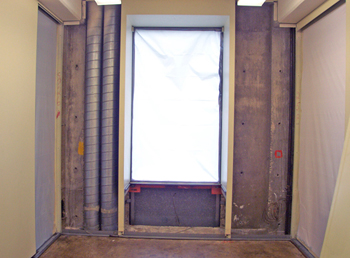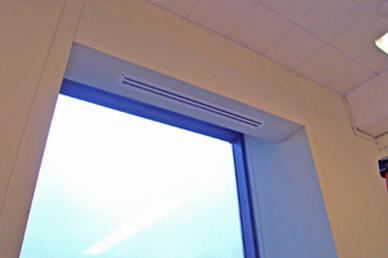|
|
|
|
|
|
|
|
|
|
|
|
 |
 |
 |
 |
|||||||
|
|
||||||||||
 |
 |
 |
 |
 |
 |
 |
 |
|||
Energy Saving Office Study
Overview
Plant Division contractor, Calixto Reyes, installing insulation. The Building and Fire Research Laboratory, working with the Plant Division, has embarked on a project to reduce the energy used to heat and cool offices within the general purpose laboratories. The project consists of retrofitting an existing office with energy saving features and making a series of measurements to quantify the potential energy savings compared to an adjacent unmodified office. The impetus for this study was a document authored by A. Hunter Fanney, Leader of the Heat Transfer and Alternative Energy Systems Group, documenting a number of ways in which NIST could reduce its energy consumption "Ideas to Reduce NIST Energy Consumption and Peak Demand Charges."
The original NIST laboratory buildings were constructed in the 1960s when energy usage concerns were minimal. The current windows consist of a single pane of glass and the walls are typically un-insulated. Add to this the fact that the heating units in each office are not thermally insulated from exterior metal panels and significant paths for air leakage exist and we have a recipe for a significant waste of energy. NIST spent over $16M on electricity and $11 M on natural gas in FY 06.
Project Details
The project consists of a number of improvements to a single office within the Building Research Laboratory (Bldg 226). The improvements being made include:
Window Unit - The single pane glass has been removed and replaced with an insulated glass unit that consists of two pieces of glass separated by a space filled with argon gas. Argon has significantly lower thermal conductivity than air. One of the surfaces has been treated with a low emissivity coating reducing heat transfer due to radiation.
Exterior Walls - The bare concrete walls were insulated using glass fiber insulation having a nominal R-value of 2.3 K.m2/W. The reflective surface facing of the insulation and the air apace between the insulation and interior metal panels adds an additional barrier to the transfer of heat between the exterior of the building office space. The metal panels above and beneath the window units were insulated with 100 mm of rigid foam board insulation (nominal R value of 3.5 K.m2/W) and subsequently covered with glass fiber insulation, identical to that used to insulate the exterior concrete walls.
Air Gaps – The gaps surrounding the ducts running from the through the exterior wall of the office space have been filled with foam and/or insulation to prevent air leakage between floors. Air gaps between the metal exterior panels and adjacent concrete walls were sealed.
Heating/Cooling Cool Unit – The heating and cooling unit in the office was removed and replaced with a unit in the attic. Unlike the current system which supplies cool air to the offices and subsequently heats the air using a radiator unit in each office, all of the conditioning of the air would take place in the attic prior to being delivered to the individual office spaces. This would offer better temperature control, add approximately 0.9 m2 of floor space that is currently occupied by the existing heating coil unit, and remove the water supply and return piping from the exterior walls. Removal of the piping from the walls (aging pipes and associated fittings) would simplify maintenance procedures as well as eliminate water leakage within the walls when a pipe or fitting fails.
Uninsulated Wall Showing Concrete Structure Insulated Wall (awaiting window upgrade) New Air Distribution Vent to Replace
Existing Heating Coil Units Under the Window
Measurements
Heat Transfer and Alternative Energy Group members
Michael Couch (foreground) and Luis Luyo installing instrumentation.A series of measurement will be made to capture the energy saving benefits associated with the retrofits. The retrofitted office and an adjacent office have been vacated for this study. False walls made from extruded polystyrene are being constructed in both offices to isolate the exterior walls of both offices from the interior of the building. A calorimetric technique will be used to compare the energy lost through the exterior wall of the retrofitted office to the unmodified control office. Blower door test will be conducted to measure the decrease in air infiltration from the exterior. Finally thermographic images will be made of the exterior walls of the control office and the retrofitted office.
Results
- Final presentation of results showing the energy savings attributed to additional wall insulation and insulated window unit. (PDF Presentation)
Contacts:
- A. Hunter Fanney,
Building and Fire Research Laboratory
Heat Transfer and Alternative Energy Systems Group- Jatin Patel,
Plant Division
|
Privacy Policy / Security Notice / Accessibility | Disclaimer | FOIA NIST is an agency of the U.S. Department of Commerce |

|
Last updated: 10/3/2007




